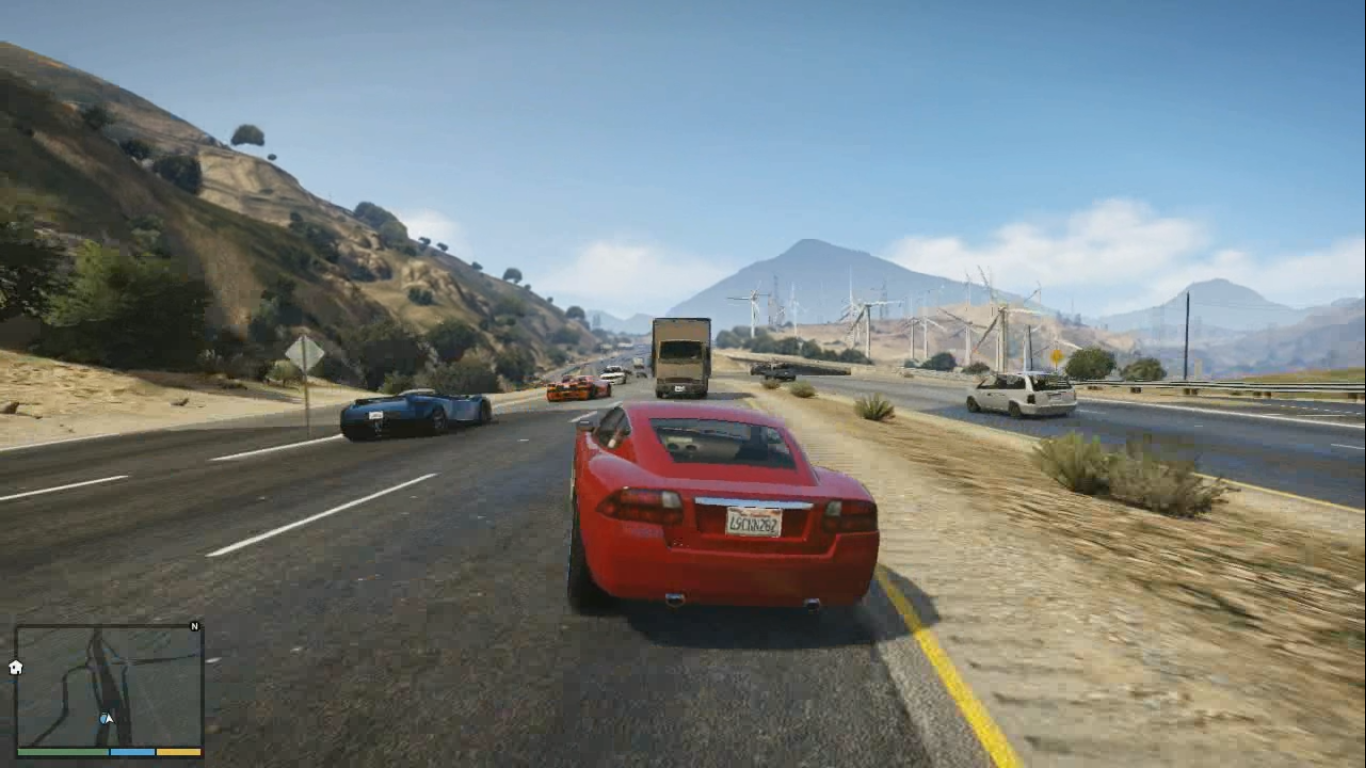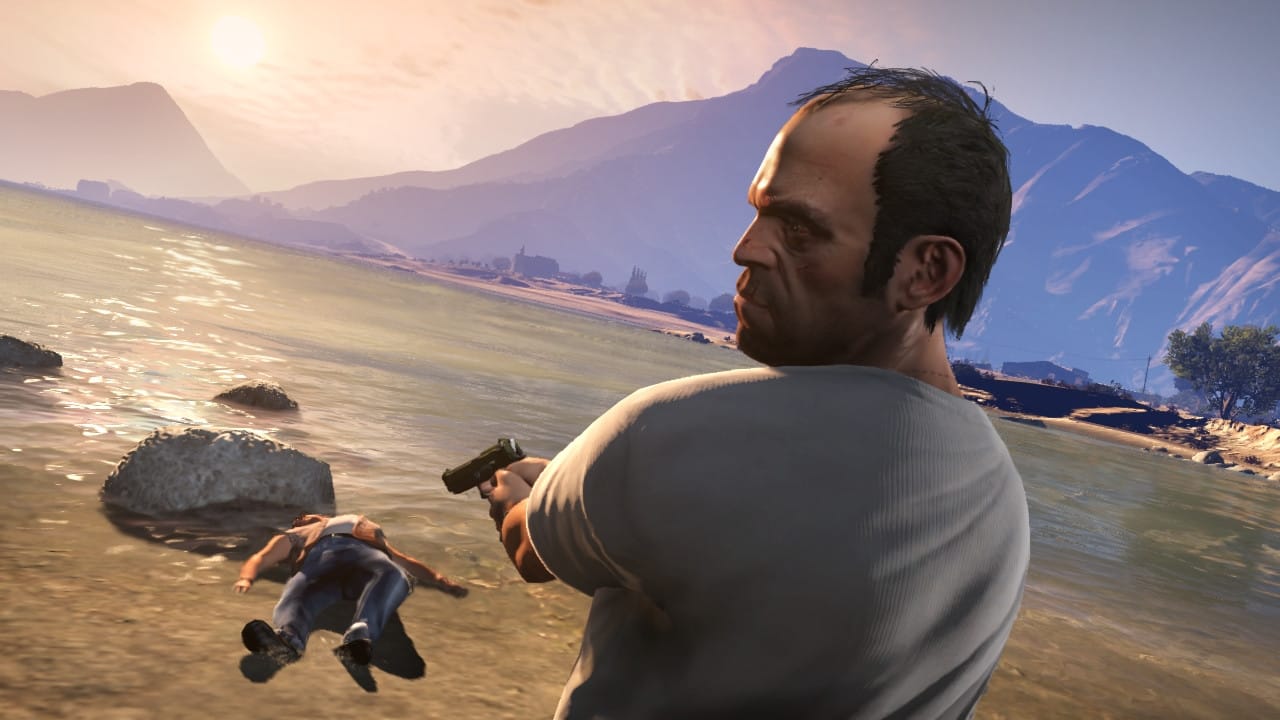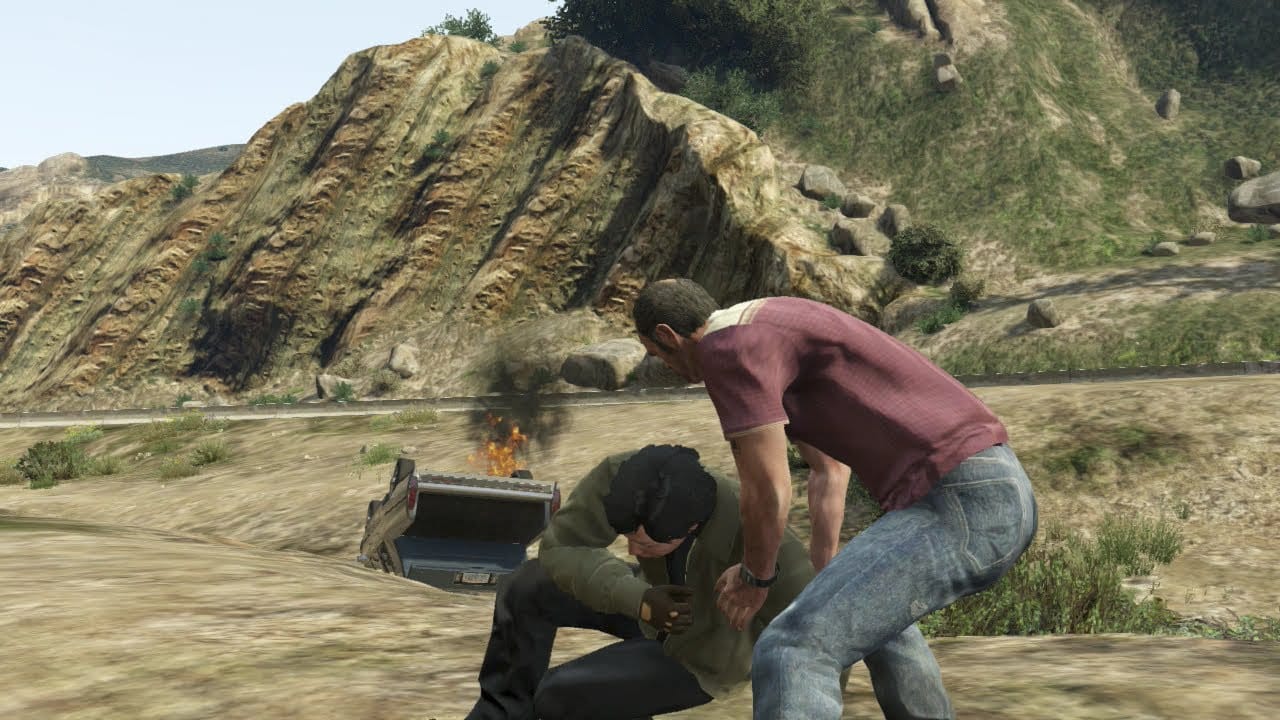The weird moral time travel in GTA V

I was driving through Blaine County in the early evening and saw the flaming remains of a car crash in the highway median, which was somewhat unusual because the non-player characters in Grand Theft Auto V seemed to be relatively competent drivers until I caused an incident. Not having driven this stretch of road before, I knew I wasn’t responsible for the carnage. So, out of curiosity (and moral imperative after trying to pass the scene only to hear a woman shouting for help), I stopped.
Taliana Martinez was a getaway driver caught in a botched robbery and sent careening off the road after being stabbed by one of her crew members. I was too slow in driving to her safehouse and she died in the passenger seat right as I pulled into her driveway. Somewhat peeved, I pushed her body out of the car and drove back to the city.

On my way back to Michael’s house, I passed an alley in Vinewood where a woman was being threatened at gunpoint by a mugger. I parked and attempted to run to her aid but she was shot as I crossed the street. With two incidents in such quick succession, I felt haunted by dead women.
Then the events repeated, and kept repeating, until I stepped in to stop them. It seemed like it didn’t matter if it was day or night. I passed the same Vinewood alley, the same spot on the freeway toward Sandy Shores. Same girls in the same outfit. I imagine if I had let it gone on longer, I might have made it want to end out of pure annoyance at hearing the dialogue repeated so many times. But rather than go totally callous, I found myself looking at the entire game as a tragi-comic closed loop of time, a universe in which there was limited evil to be done and a strong incentive to end certain evil acts in spite of all the opportunities to blow up armored cars.
Destruction is encouraged as long as you stay within the established boundaries. The map, while large, will kill you if you try to go beyond it, but there are also enough distractions to entice you back to prevent you from seeking the boundary in the first place. It’s a little reminiscent of the island in LOST—and the game creators seem aware. There is even a hatch under the ocean on one corner of the map.
the only real indicator that time is passing at all is the changing stock market
Your freedom comes at a price in this open world. You can live in an eternal summer where the progression of time is merely illusory. You’ll never age and never die, but that means your kids will never grow up enough to leave the house or your friends might never get wise to their mistakes and the stakes of your missions seem less and less dire. You might have agreed to a heist that appears time sensitive, like assisting the FIB in stealing a bio-weapon from a rival government agency, but you can pass five or 100 days in the game with very little nagging from other characters about fulfilling your commitment or the threat of failure via missed opportunity.
There’s just one season in the game’s main campaign and the only real indicator that time is passing at all is the changing stock market.
No children appear anywhere in Los Santos or Sandy Shores or anywhere in between, so they will never get hit with stray bullets. While the representation of sex workers is shallow and entirely expected (no real agency, victims of abusive pimps, etc), there are other instances in which the player is rewarded for treating women with respect: rescuing a runaway bride escaping her abuser; preventing the sexual assault of one young woman being preyed upon by two naked old men; preventing a woman from being shot during a mugging.

For the player tuned in to it, there is a very clear moral structure being promoted here. It’s fair to point out that many vulnerable people are left out of this moral structure, but such is the nature of a science fictional universe with a somewhat vindictive god.
Even if players follow their most evil inclinations, there is a strict limit to the amount of bad one can perpetuate.
Los Santos’ insular universe seems to be working to correct itself. If any of the three protagonists die, you jump back in time to before your death, imposing an immortality similar to Bill Murray in Groundhog Day. The non-player characters seem to be participating in the causal loop as well, no matter how many times you kill them. They regenerate identical to their former selves, sometimes startlingly quickly. During one rampage as Trevor, I beat a man to death simply because he looked like a tech bro: bad haircut, hoodie, cargo shorts and flip flops. A few minutes later, I turned a corner on a nearby block and his double was there, walking by as if I hadn’t just assaulted him.
there is a strict limit to the amount of bad one can perpetuate
Death is only permanent for a select few inhabitants whom it is obvious the world would be better without. This is sort of a warped version of the “fixed point” theory of time travel popularized by Doctor Who: there are just certain events that you can’t change because they are so critical to keeping a universe’s timeline intact. But in Los Santos, instead of showing the consequences of the timeline collapsing, it just forces your hand to keep trying. Or, from a more pessimistic perspective, dooms you to repeat your actions until you get it right, until you’ve purged all the evil from the place by totally exhausting your options and figuring out who you can put in the ground permanently and whose suffering will repeat due to your inaction.
Without your interference, Taliana will stay on the highway bleeding eternally until you pick her up; the anonymous woman in the ally will keep getting shot. The starlet will keep getting trapped by paparazzi. The woman caught by the rogue members of the Altruist cult will keep getting sexually assaulted. The horror is in the repetition, but once you’ve closed the loop, you effectively take the events out of time forever. Or, if interpreted through the many worlds theory, you create a new, better timeline every time you decide to interrupt events. It’s all in service of the greater good.

This moral universe is very heavy handed. It practically screams at you that you have the agency to change things, to prevent suffering of the (relatively) innocent, but giving you a little more agency with the assholes.
Dom, the thrill-seeking dickwad who coerces Franklin into participating in many death-defying stunts like parachuting onto moving semi trucks, is allowed to either live or die permanently, depending on your reaction to the final tip-off offered to you by the magical golden retriever. You can either obey Devin Weston or stuff him in a trunk and shove him into the ocean. You can continue to be Steve Haines’ lackey or end him during a reality television shoot. Whichever way you decide is permanent. Depending on which final decision you make as Franklin, all three protagonists survive or only two do.
These major decisions don’t get a redo in the same way as the seemingly more minor events, suggesting that the major protagonists and antagonists are not fixed in time in the same way as everyone around them. They’re timelords, Phil Connors, Billy Pilgrims: unstuck in a limited span of time, soaked in blood and seeking redemption. Bleak, but at least it’s always sunny in Los Santos.



